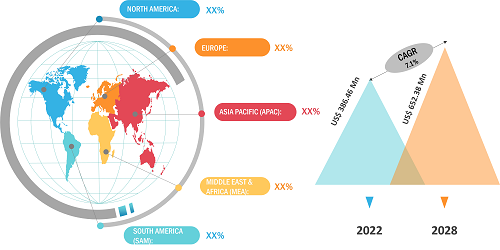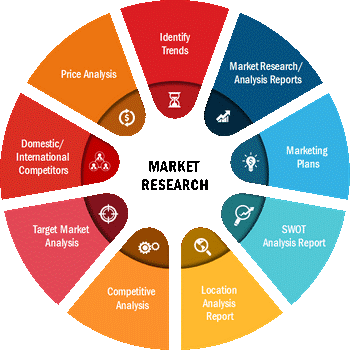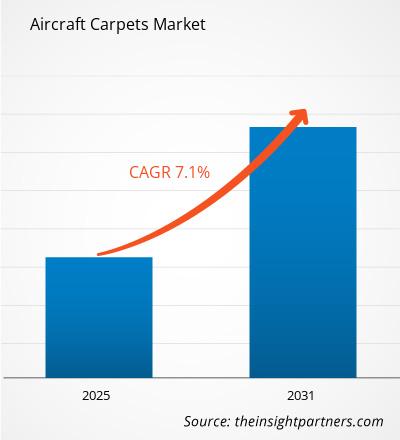Si prevede che il mercato dei tappeti per aerei crescerà da 386,46 milioni di dollari nel 2022 a 652,38 dollari milioni entro il 2031; si stima che crescerà a un CAGR del 7,1% dal 2022 al 2031.
Il tappeto per aereo è un rivestimento del pavimento dell'aereo realizzato in materiale tessile. Il suo strato superiore è costituito da pelo attaccato al supporto. La crescente domanda di tappeti per aerei è attribuita alle sue proprietà di resistenza al rumore e alle vibrazioni. Inoltre, si prevede che la crescente domanda di tappeti leggeri per aerei alimenterà la crescita del mercato dei tappeti per aerei nei prossimi anni.
DINAMICHE DEL MERCATO< /span>
Negli ultimi anni, la modernizzazione e l'espansione delle compagnie aeree hanno aumentato la domanda di aerei. La domanda globale di voli nazionali è aumentata rispetto alla domanda di voli internazionali. Pertanto, la domanda di aerei a fusoliera stretta è in aumento. Inoltre, i produttori di aerei commerciali stanno sviluppando sottosistemi efficienti e sofisticati e tecnologie avanzate. Questi fattori incoraggiano i produttori a innovare tappeti distinti per i pavimenti degli aerei. Ad esempio, Tarkett (Desso) ha sviluppato moquette autoadesive e leggere, con un peso ridotto del 40% rispetto agli standard di mercato. Il tappeto autoadesivo elimina la necessità del nastro adesivo e consente un'installazione efficiente. Tarkett ha sviluppato un tappeto autoadesivo per il Boeing 787 Dreamliner, diventando così fornitore approvato di aerei Boeing. Pertanto, si prevede che l'aumento degli aerei e la proprietà di jet privati aumenteranno la domanda di tappeti per aerei nei prossimi anni.
AMBITO DI MERCATO
Il rapporto "Previsioni del mercato globale dei tappeti per aeromobili fino al 2031" mira a fornire una panoramica del mercato dei tappeti per aeromobili con una segmentazione dettagliata del mercato per tipo di materiale e applicazione. Fornisce statistiche chiave basate sulle prestazioni dei principali attori del mercato e offre le principali tendenze e opportunità nel mercato.
Approfondimenti strategici
SEGMENTAZIONE DEL MERCATO
Il mercato globale Il mercato dei tappeti per aerei è suddiviso in base al tipo di materiale e all’applicazione. In base al tipo di materiale, il mercato è segmentato in nylon, lana, poliammide, e altri. In base all'applicazione, il mercato è segmentato in aerei commerciali, aerei militari/di difesa, elicotteri e altri.
Il mercato globale dei tappeti per aerei è segmentato in cinque regioni principali: Nord America, Europa, Asia Pacifico (APAC), Medio Oriente e Asia. Africa (MEA) e Sud & America Centrale. Il rapporto copre un'analisi e previsioni di 18 paesi in tutto il mondo insieme alle tendenze e alle opportunità prevalenti in queste regioni.
L'Asia del Pacifico ha dominato il mercato dei tappeti per aerei nel 2021. L'Asia del Pacifico ha il maggior numero di passeggeri aerei rispetto ad altre regioni, a causa della presenza di economie emergenti e densamente popolate come Cina e India. Ad esempio, nel 2021, l’industria aeronautica in Cina era sull’orlo della ripresa, trainata soprattutto dal traffico interno. La forte crescita del mercato nella regione è dovuta alla crescente domanda di tappeti per aerei nella regione. C'è una forte domanda per diversi tipi di tappeti per aerei a causa dell'aumento delle vendite di jet privati e dei viaggi di lusso con le compagnie aeree. La figura seguente mostra il trend di crescita dei ricavi nel mercato dei tappeti per aerei:

< span style="font-family: verdana, geneva, sans-serif; font-size: 10pt;">Fonte: The Insight Partners Analysis
Il rapporto analizza i fattori, quali fattori trainanti, restrizioni, opportunità e tendenze future, che influiscono sul mercato dei tappeti per aeromobili. Fornisce inoltre un'analisi esaustiva delle cinque forze di Porter dei fattori che influenzano il mercato in queste regioni.
IMPATTO DELLA PANDEMIA DA COVID-19
La pandemia di COVID-19 ha avuto un impatto negativo sul mercato complessivo dei tappeti per aerei. La pandemia ha ostacolato il traffico aereo di passeggeri nel 2021, diminuendo le attività di volo. L’imposizione del blocco ha temporaneamente interrotto varie attività manifatturiere, limitando l’offerta, che ha frenato il mercato dei tappeti per aerei. Inoltre, il trasporto delle materie prime ha incontrato difficoltà a causa delle restrizioni sui viaggi, che hanno avuto un impatto negativo sull'economia globale.
La pandemia di COVID-19 ha portato alla devastazione finanziaria dell'intera catena del valore dell'aviazione, in particolare delle compagnie aeree. Secondo l’Organizzazione per l’aviazione civile internazionale (ICAO), i ricavi per chilometri passeggeri (RPK) volati in tutto il mondo per le compagnie aeree sono diminuiti del 94% nel 2021. Gli RPK internazionali sono diminuiti del 98%, poiché i voli passeggeri sono diminuiti. Si prevede che i volumi del traffico nazionale e internazionale diminuiranno del 50,4% per il 2021, rispetto ai valori del 2021. L'ICAO ha inoltre stimato che, entro la fine del 2021, la pandemia di COVID-19 ha portato a una riduzione del traffico passeggeri internazionale di linea del 71%. % della capacità dei posti e riduzione fino a 1,5 miliardi di passeggeri in tutto il mondo. La riduzione dei voli passeggeri e privati ha ridotto la domanda di tappeti per aerei.
In Nel 2021, le tre principali compagnie aeree di proprietà del governo, China Southern Airlines, China Eastern Airlines e Air China, hanno annullato la consegna di oltre 100 aerei da Boeing e Airbus. Inoltre, il traffico passeggeri in India si è ripreso a un ritmo ottimale grazie all'enorme domanda interna e al crescente settore del turismo.
Nel 2021, il mercato ha assistito a una crescita poiché i governi di vari paesi hanno annunciato un allentamento di diverse restrizioni, compresi i blocchi. I produttori hanno ripreso le loro attività a pieno regime, il che li ha aiutati a colmare il divario tra domanda e offerta. Molti produttori hanno ampliato le proprie capacità produttive per soddisfare la crescente domanda di tappeti per aerei.
ATTORI DEL MERCATO
Varie aziende del Il mercato dei tappeti per aerei si sta concentrando su strategie di crescita organica, come lanci di prodotti, approvazioni di prodotti, brevetti ed eventi. Acquisizioni, partnership e collaborazioni sono tra le attività strategiche di crescita inorganica testimoniate nel mercato. Queste attività hanno aperto la strada all'espansione del business e alla base di clienti degli operatori del mercato. Si prevede che gli operatori del mercato sperimenteranno opportunità di crescita redditizie nei prossimi anni a causa della crescente domanda di tappeti per aerei.
Il rapporto include profili aziendali chiave che operano nel mercato dei tappeti per aeromobili, insieme alle loro analisi SWOT e strategie di mercato. Si concentra inoltre sui principali operatori del settore. informazioni, come profili aziendali, componenti e servizi offerti, informazioni finanziarie degli ultimi tre anni e sviluppi chiave negli ultimi cinque anni.
Aziende chiave che operano nel mercato dei tappeti per aerei
- SCS Interiors
- Tappeti BIC
- Lantal Textiles AG
- Spectra Interior Products
- Industrial Neotex SA
- Aircraft Interior Products Inc.
- Tarkett
- Tessitura botanica
- Luxia Innovation
- Tappeti Vandana
Il team di ricerca e analisi dedicato del partner Insight è composto da professionisti esperti con competenze statistiche avanzate e offre varie opzioni di personalizzazione nello studio esistente.

- Analisi storica (2 anni), anno base, previsione (7 anni) con CAGR
- Analisi PEST e SWOT
- Valore/volume delle dimensioni del mercato - Globale, regionale, nazionale
- Industria e panorama competitivo
- Set di dati Excel



Report Coverage
Revenue forecast, Company Analysis, Industry landscape, Growth factors, and Trends

Segment Covered
This text is related
to segments covered.

Regional Scope
North America, Europe, Asia Pacific, Middle East & Africa, South & Central America

Country Scope
This text is related
to country scope.
Trends and growth analysis reports related to Chemicals and Materials : READ MORE..
The List of Companies
- SCS Interiors
- B.I.C. Carpets
- Lantal Textiles AG
- Spectra Interior Products
- Industrial Neotex SA
- Aircraft Interior Products Inc.
- Tarkett
- Botany Weaving
- Luxia Innovation
- Vandana Carpets
The Insight Partners performs research in 4 major stages: Data Collection & Secondary Research, Primary Research, Data Analysis and Data Triangulation & Final Review.
- Data Collection and Secondary Research:
As a market research and consulting firm operating from a decade, we have published and advised several client across the globe. First step for any study will start with an assessment of currently available data and insights from existing reports. Further, historical and current market information is collected from Investor Presentations, Annual Reports, SEC Filings, etc., and other information related to company’s performance and market positioning are gathered from Paid Databases (Factiva, Hoovers, and Reuters) and various other publications available in public domain.
Several associations trade associates, technical forums, institutes, societies and organization are accessed to gain technical as well as market related insights through their publications such as research papers, blogs and press releases related to the studies are referred to get cues about the market. Further, white papers, journals, magazines, and other news articles published in last 3 years are scrutinized and analyzed to understand the current market trends.
- Primary Research:
The primarily interview analysis comprise of data obtained from industry participants interview and answers to survey questions gathered by in-house primary team.
For primary research, interviews are conducted with industry experts/CEOs/Marketing Managers/VPs/Subject Matter Experts from both demand and supply side to get a 360-degree view of the market. The primary team conducts several interviews based on the complexity of the markets to understand the various market trends and dynamics which makes research more credible and precise.
A typical research interview fulfils the following functions:
- Provides first-hand information on the market size, market trends, growth trends, competitive landscape, and outlook
- Validates and strengthens in-house secondary research findings
- Develops the analysis team’s expertise and market understanding
Primary research involves email interactions and telephone interviews for each market, category, segment, and sub-segment across geographies. The participants who typically take part in such a process include, but are not limited to:
- Industry participants: VPs, business development managers, market intelligence managers and national sales managers
- Outside experts: Valuation experts, research analysts and key opinion leaders specializing in the electronics and semiconductor industry.
Below is the breakup of our primary respondents by company, designation, and region:

Once we receive the confirmation from primary research sources or primary respondents, we finalize the base year market estimation and forecast the data as per the macroeconomic and microeconomic factors assessed during data collection.
- Data Analysis:
Once data is validated through both secondary as well as primary respondents, we finalize the market estimations by hypothesis formulation and factor analysis at regional and country level.
- Macro-Economic Factor Analysis:
We analyse macroeconomic indicators such the gross domestic product (GDP), increase in the demand for goods and services across industries, technological advancement, regional economic growth, governmental policies, the influence of COVID-19, PEST analysis, and other aspects. This analysis aids in setting benchmarks for various nations/regions and approximating market splits. Additionally, the general trend of the aforementioned components aid in determining the market's development possibilities.
- Country Level Data:
Various factors that are especially aligned to the country are taken into account to determine the market size for a certain area and country, including the presence of vendors, such as headquarters and offices, the country's GDP, demand patterns, and industry growth. To comprehend the market dynamics for the nation, a number of growth variables, inhibitors, application areas, and current market trends are researched. The aforementioned elements aid in determining the country's overall market's growth potential.
- Company Profile:
The “Table of Contents” is formulated by listing and analyzing more than 25 - 30 companies operating in the market ecosystem across geographies. However, we profile only 10 companies as a standard practice in our syndicate reports. These 10 companies comprise leading, emerging, and regional players. Nonetheless, our analysis is not restricted to the 10 listed companies, we also analyze other companies present in the market to develop a holistic view and understand the prevailing trends. The “Company Profiles” section in the report covers key facts, business description, products & services, financial information, SWOT analysis, and key developments. The financial information presented is extracted from the annual reports and official documents of the publicly listed companies. Upon collecting the information for the sections of respective companies, we verify them via various primary sources and then compile the data in respective company profiles. The company level information helps us in deriving the base number as well as in forecasting the market size.
- Developing Base Number:
Aggregation of sales statistics (2020-2022) and macro-economic factor, and other secondary and primary research insights are utilized to arrive at base number and related market shares for 2022. The data gaps are identified in this step and relevant market data is analyzed, collected from paid primary interviews or databases. On finalizing the base year market size, forecasts are developed on the basis of macro-economic, industry and market growth factors and company level analysis.
- Data Triangulation and Final Review:
The market findings and base year market size calculations are validated from supply as well as demand side. Demand side validations are based on macro-economic factor analysis and benchmarks for respective regions and countries. In case of supply side validations, revenues of major companies are estimated (in case not available) based on industry benchmark, approximate number of employees, product portfolio, and primary interviews revenues are gathered. Further revenue from target product/service segment is assessed to avoid overshooting of market statistics. In case of heavy deviations between supply and demand side values, all thes steps are repeated to achieve synchronization.
We follow an iterative model, wherein we share our research findings with Subject Matter Experts (SME’s) and Key Opinion Leaders (KOLs) until consensus view of the market is not formulated – this model negates any drastic deviation in the opinions of experts. Only validated and universally acceptable research findings are quoted in our reports.
We have important check points that we use to validate our research findings – which we call – data triangulation, where we validate the information, we generate from secondary sources with primary interviews and then we re-validate with our internal data bases and Subject matter experts. This comprehensive model enables us to deliver high quality, reliable data in shortest possible time.

 Ottieni un campione gratuito per questo repot
Ottieni un campione gratuito per questo repot